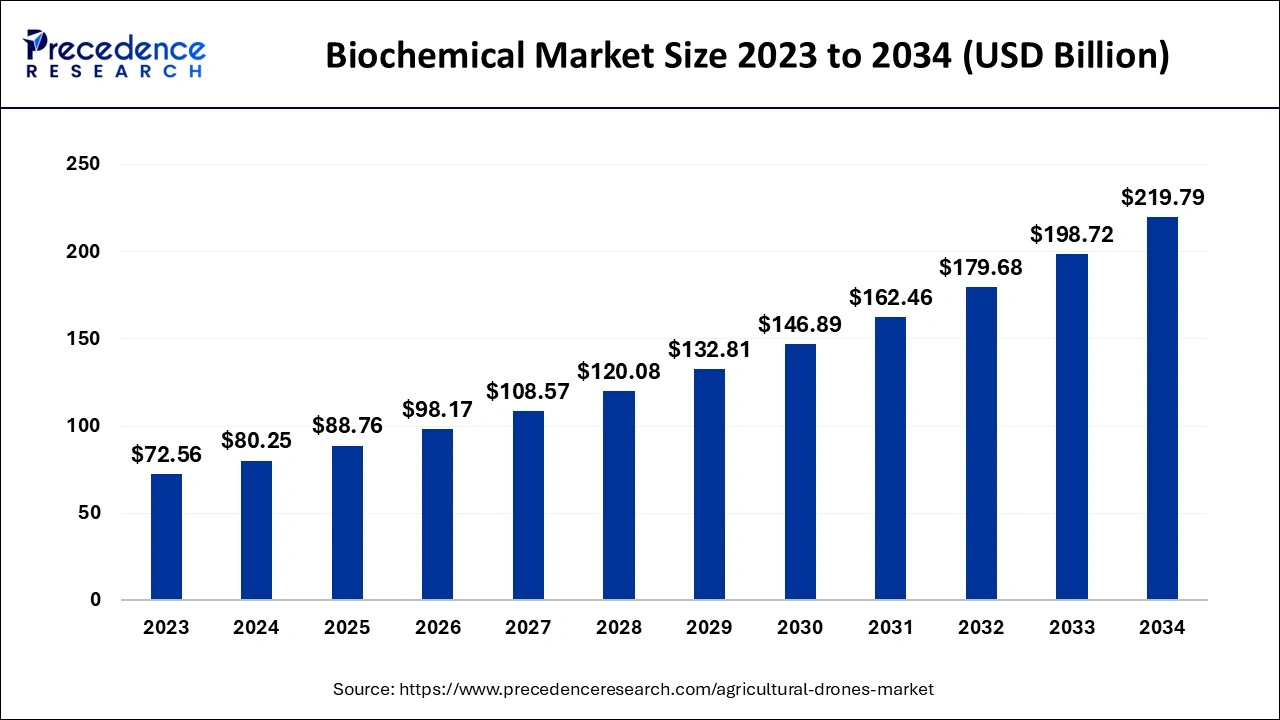The global biochemical market size accounted for USD 80.25 billion in 2024, grew to USD 88.76 billion in 2025 and is projected to surpass around USD 219.79 billion by 2034, representing a healthy CAGR of 10.60% between 2024 and 2034.
The global biochemical market size accounted for USD 80.25 billion in 2024 and is anticipated to reach around USD 219.79 billion by 2034, expanding at a CAGR of 10.60% from 2024 to 2034.

The bio-chemicals are produced using a variety of raw materials, including corn, sugarcane, sugar beet, wheat, and cassava. Overall, it is less expensive to make bio-based chemicals than conventional, non-renewable chemicals due to the low manufacturing costs of these raw materials. Furthermore, there are no barriers to mass synthesizing these fundamental elements. Biochemical refers to any chemical compound, whether it is produced artificially using industrial biotechnology or organically. Biochemicals are more environmentally friendly than chemicals made from fossil fuels. These bio-based chemicals may share structural characteristics with other chemicals already in use or they may have whole unique structures that open up innovative possibilities. Bio-chemicals are becoming more popular among sustainable businesses, which is why their demand is rising. Leading packaging manufacturers are implementing sustainable techniques to provide environmentally friendly products in an effort to prevent plastic pollution.
Biochemicals are on the rise as a result of governments putting more emphasis on environmental issues. For long-term, sustainable growth, nations, and industry are looking for renewable materials. It is anticipated that biochemicals like hormones and enzymes would be crucial in triggering, catalyzing, and inhibiting a variety of biochemical and physiological responses.
| Report Coverage | Details |
| Market Size in 2024 | USD 80.25 Billion |
| Market Size by 2034 | USD 219.79 Billion |
| Growth Rate from 2024 to 2034 | CAGR of 10.60% |
| Base Year | 2023 |
| Forecast Period | 2024 to 2034 |
| Segments Covered |
|
| Regions Covered |
|
The biodiesel sector is anticipated to have the greatest market share by type in the upcoming years since it has historically dominated the market with the highest revenue share and is anticipated to continue to expand strongly in that time. The increasing demand for clean and renewable fuel sources and the increase in global energy consumption are the primary drivers of the segment's growth. A thriving automobile industry is another significant factor that promotes growth.
Growing environmental consciousness and consumer comprehension of its benefits have led to the widespread use of biodiesel throughout the world. A further factor encouraging the use of biodiesel is the limited availability and rising expense of non-renewable energy sources including gasoline, diesel, and liquefied petroleum gas (LPG). A number of technological advancements are also painting a positive picture for the market, such as the arrival of third-generation biofuels generated from algae, which can produce a wide variety and a significant volume of ethanol in contrast to earlier feedstocks.
On the basis of application, the automotive segment has captured the largest market share in 2022. Because of rising disposable money and excellent living standards, the automotive industry is expanding. Because consumers are more likely to live opulent lives, the automotive industry is anticipated to dominate the biochemicals market due to the demand for biodiesel.
Food processing use is anticipated to expand significantly. Food ingredients, which are used in the food processing sector, are produced using bio-based chemicals. The Middle East's growing packaged food industry is predicted to increase demand for food ingredients, which is further predicted to increase demand for bio-based chemicals.
On the basis of geography, Asia-Pacific is expected to continue to be among the most alluring markets and this region is accounted for the majority revenue share in the market throughout the projection period. The Asia Pacific region is now the largest region in terms of the worldwide market for biochemicals due to the enormous growth in the demand for biofuels.
The use of biochemicals in the pharmaceutical and food processing industries is on the rise, which is good news for the Asia Pacific biochemical industry. The consumer trend toward eco-friendly products is projected to soon produce promising growth opportunities for the Indian biochemical market. The promotion of cleaner fuels by the Indian government is expected to enhance the use of biodiesel. The railways, the transportation sector, and other organizations use biodiesel in India.
This can be attributed to a surge in consumer spending in the region, the adoption of a healthy lifestyle, and the rapid expansion of end-use industries including nutraceuticals, pharmaceuticals, personal care, and cosmetics. The regional market is anticipated to grow as a result of expanding amino acid production and rising feed additive exports from significant countries like China and Japan. Amino acids are mostly used to treat liver and cardiovascular diseases, as well as to slow down the degeneration and weariness of muscles. Because of the growing populations in emerging countries like China and India as well as the presence of a young population, there is a high need for amino acids.
Segments Covered in the Report
By Type
By Application
By Geography
For inquiries regarding discounts, bulk purchases, or customization requests, please contact us at sales@precedenceresearch.com
No cookie-cutter, only authentic analysis – take the 1st step to become a Precedence Research client